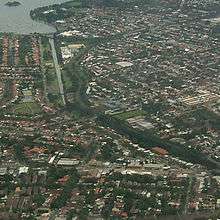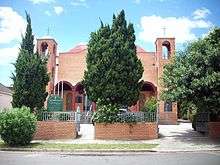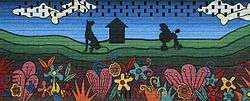Leichhardt, New South Wales
| Leichhardt Sydney, New South Wales | |||||||||||||
|---|---|---|---|---|---|---|---|---|---|---|---|---|---|
 Leichhardt Town Hall | |||||||||||||
| Coordinates | 33°53′05″S 151°09′26″E / 33.8847°S 151.1573°ECoordinates: 33°53′05″S 151°09′26″E / 33.8847°S 151.1573°E | ||||||||||||
| Population | 13,520 (2011 census)[1] | ||||||||||||
| • Density | 2,961.7/km2 (7,671/sq mi) | ||||||||||||
| Established | 1846 | ||||||||||||
| Postcode(s) | 2040 | ||||||||||||
| Area | 4.565 km2 (1.8 sq mi) | ||||||||||||
| Location | 5 km (3 mi) west of Sydney CBD | ||||||||||||
| LGA(s) | Inner West Council | ||||||||||||
| State electorate(s) | Balmain | ||||||||||||
| Federal Division(s) | Grayndler | ||||||||||||
| |||||||||||||
Leichhardt is a suburb in the Inner West[2] of Sydney, in the state of New South Wales, Australia. Leichhardt is located 5 kilometres west of the Sydney central business district (CBD) and is the administrative centre for the local government area (LGA) of the Inner West Council. The suburb is bordered by Haberfield to the west, Annandale to the east, Lilyfield to the north and Petersham, Lewisham and Stanmore to the south.
Leichhardt contains a mix of residential and commercial developments and is best known as Sydney's "Little Italy". Leichhardt residents and businesses live and work next to the Sydney CBD.
History
Aboriginal anthropology
Leichhardt was once an area broadly inhabited by the Wangal band of the Dharug (Eora) language group. The 'Eora people' was the name given to coastal Aborigines around Sydney – Eora means from this place – local Aboriginal people used this word to describe to Europeans where they came from, and in time the term became used to define Aboriginal people themselves. Wangal country was known as 'wanne' and it originally extended from the suburbs of Balmain and Birchgrove in the east to Silverwater and Auburn in the west. It is unclear how many people were in the tribe, some research indicates in the broader Sydney region there was between 8000 – 10000 indigenous people, migration over the seasons and violence between tribes would alter this number at different periods. The northern boundary was the Parramatta River. Neighbouring Darug bands were the Cadigal to the east, the Wallumattagal on the northern shore of the Parramatta River and the Bediagal to the south.
European settlement
Leichhardt is named after the Prussian explorer Ludwig Leichhardt, who in the 1840s was feted for his 4,800 km (c. 3000 mi) expedition in search of an overland route from southern Queensland to Port Essington, a British settlement on the far northern coast of Australia (some 300 km to the north of the modern city of Darwin).[3] In 1848, he famously vanished without trace on his attempt to cross the continent from the Darling Downs to the Swan River Colony on the Western Australia coast.[4]
Leichhardt was proclaimed a municipality in 1871. In 1949, it was merged with the municipalities of Annandale and Balmain. In 1967, the municipal boundary was altered to include Glebe and parts of Camperdown. In 2003, the municipal boundary was again changed, to exclude Glebe and Forest Lodge, which are now part of the City of Sydney.[5]
Commercial area
The main commercial area in Leichhardt is located on Norton Street, north of Parramatta Road and parallel to Balmain Road. The Norton Street commercial area contains a mix of residential buildings, restaurants (Italian and others), cafés, eateries and individual retail outlets, including several bookstores and grocery shops. There are also hotels, a Palace Cinema and two of the suburb's two shopping centres – MarketPlace Leichhardt and Norton Plaza. Commercial developments are also found along the length of Parramatta Road.
The Italian Forum, located just off Norton Street, is notable for its design which seeks to emulate the feel of a Mediterranean town piazza. A pedestrian-only central courtyard featuring outdoors and indoors restaurant dining as well as Leichhardt Library is surrounded by small shops and boutiques on the level above, and all overlooked by residential apartments. The second shopping centre, MarketPlace Leichhardt (formerly Market Town), is located towards Haberfield on the corner of Marion and Flood Streets. MarketPlace Leichhardt has free car parking and is home to Woolworths, Aldi, Target and over 60 specialty stores. The centre recently celebrated its 40th birthday milestone of being in the heart of Leichhardt.
Transport
Leichhardt can be accessed by several main roads including Parramatta Road, Norton Street, Balmain Road, Marion Street and Catherine Street. The City West Link Road runs along the northern border of Leichhardt and is a major arterial road, which is part of the A4 and crosses the Anzac Bridge to the CBD.
Leichhardt is well serviced by Sydney Buses through city and cross regional services. Leichhardt Bus Depot is located on the corner of William and Derbyshire Street. The following list provides the bus routes in Leichhardt:
- Metrobus 10 travels from Maroubra Junction through the City to Leichhardt.
- 480, 483, 461 all travel from the City (Queen Victoria Building) to Strathfield Station via Parramatta Road (Leichhardt) and Ashfield shops
- 440 travels from Circular Quay to Rozelle via Railway Square, Parramatta Road, Leichhardt Town Hall, Rozelle (Terry Street)
- 436, 438, 439 all travel from Circular Quay, Railway Square, Parramatta Road, Leichhardt Town Hall, Haberfield, Rodd Point and Chiswick (436), Abbotsford (438), Mortlake (439)

- L37 travels at limited stops from Haberfield to Wynyard via Leichhardt, Rozelle, and Anzac Bridge
- L38 travels at limited stops along the 438 route
- L39 travels at limited stops along the 439 route
- 470 travels from Circular Quay, Forest Lodge, Annandale and Lilyfield.
- 444 travels from Balmain East Wharf (Darling Street), Rozelle, Leichhardt, Petersham, Dulwich Hill, Hurlstone Park, Canterbury Station, Campsie Station
- 445 travels from Balmain East Wharf (Darling Street), Rozelle, Leichhardt, Lilyfield Light Rail Stop, Petersham, Dulwich Hill, Hurlstone Park, Canterbury Station, Campsie Station
- 370 travels from Leichhardt to Coogee via Glebe, Newtown, and University of New South Wales
The southern portion of Leichhardt is serviced by trains at the nearby Petersham railway station, on the Airport, Inner West & South Line. The station is an eight-minute walk from Norton St, along Railway St.
The western and northern portions of Leichhardt are serviced by trams (light rail) on the Dulwich Hill Line of Sydney's light rail network. Leichhardt North lies on the northern border with Lilyfield, adjacent to the City West Link. Hawthorne, serving the north-west of the suburb, and Marion, near Marion Street, are on the western border with Haberfield. Taverners Hill is adjacent to Parramatta Road and lies in the south-west corner of the suburb.
Leichhardt was served by trams from Sydney's former network from 1887 to the 1950s. The Annandale Line ran down Norton Street. The current bus depot at the top of William Street was a 12 road depot, designed to serve a number of planned lines that were never built. Instead, it was used to stored surplus trams in the off peak period, and was rebuilt as the Government Bus Workshops in 1937. A small spur of track remained and was later used by tour trams going through the depot yard nearest Pioneer Park. It is now Sydney Buses South Western Headquarters.
Houses
Being situated close to the city, Leichhardt is an area for great capital growth as it very central and has a lot to offer, so housing is not very cheap and is a much sought after. The architecture in Leichhardt ranges from Victorian single fronted brick homes to modern new homes and apartment blocks.
Churches and schools

- All Souls Anglican Church on the corner of Norton Street and Marion Street
- Leichhardt Baptist Church on the corner of Foster Street and Lords Road
- Leichhardt Congregational Church in Elswick Street
- Leichhardt Uniting Church in the old Methodist Central Hall on Wetherill Street
- St. Columba and The Holy Souls Parish (Catholic) in Elswick Street
- St. Fiacre's Parish (Catholic) in Catherine Street
- St. Joseph's Catholic Church in Roseby Street
- The Parish of St. Gerasimos Church (Greek Orthodox) in Henry Street
Leichhardt has a number of primary schools and one secondary school.
- Kegworth Public School, a primary, co-educational public school, established in 1887, is located on Tebbutt Street.
- Leichhardt Public School, a primary, co-educational public school, established in 1891, is located on Marion Street.
- St. Columba's Primary School, a Catholic, primary, co-educational public school, established in 1898, is located on Elswick Street.
- St. Fiacre's Primary School, a Catholic, primary, co-educational public school, established in 1894, is located on Catherine Street.
- Sydney Secondary College – Leichhardt campus, a secondary, co-educational public school (partially selective; 7–10), established in 2002, is located on Balmain Road.
Landmarks
- Leichhardt Fire Station on the corner of Marion Street and Balmain Road
- Leichhardt Hotel (Former) on the corner of Balmain Road and Wetherill Street
- Norton Hotel on the corner of Norton Street and Parramatta Road
- Old Cyclops Toy Factory on William Street
- Palace Cinema on Norton Street
The following buildings are listed on the Register of the National Estate:[6]
- Leichhardt Town Hall, corner Norton and Marion Streets (1888)
- Post Office, corner Norton and Weatherill Streets (1888)
- Public School Buildings, Marion Street (first building 1891, second building 1897)
- Church of England, corner Norton and Marion Streets (1883)
Parks and recreation
- Pioneers Memorial Park is located in Norton Street and features large grassed areas, native and formal plantings, a war memorial and the Bicentennial Rotunda. It was formally the location for the Balmain Cemetery.[7]
- War Memorial Park is situated on the corner of Moore and Catherine Streets and features large grassed areas as well as shaded areas and a children's playground.
- 36th Battalion Park is situated on the corner of Mackenzie and Hill St and features medium-sized grassed park, electric barbecue, children's play equipment and a half-size basketball court.
- Blackmore Oval is located off Canal Road and is used to play competitive Rugby League and Baseball, amongst others, in the local area.
- Leichhardt Oval: Home to NRL team Wests Tigers and previously for the NSW Premier League team APIA Leichhardt Tigers.
- Lambert Park (Leichhardt) is located on Marion Street and is the home of NSW Premier League team APIA Leichhardt Tigers.
Culture
Leichhardt is home to many creative industry workers and is known for its colourful and inventive mural art, such as the panorama at the Renwick Lane and at the Hawthorne Canal Railway Underpass. Leichhardt has access to many art and cultural organisations. Commercial galleries are found throughout the area and Boomali Gallery, the Aboriginal Arts Organisation is situated in Flood Street in Leichhardt.
The Italian community has a wealth of social and cultural organisations located in Leichhardt, and work is underway everyday to develop the Italian Forum Cultural Centre. Co.As.It. is one of them and they provide a range of culturally and linguistically appropriate services to enhance the quality of life of the community and to promote the Italian language and culture in New South Wales.

Leichhardt is the yearly host of the Italian Festa on Norton Street where local traffic is temporarily closed on Norton and neighbouring streets transforming surroundings into a huge European style outdoor café, celebrating Leichhardt's cultural diversity with an International Food Fair, gift stalls, community expos and live entertainment throughout the day. Leichhardt is also known for its café culture with cafés in abundance. The oldest café in the area is Café Sport, which is located on Norton Street.
Population
Demographics
| 2006 Census: Leichhardt | |||
|---|---|---|---|
| Leichhardt[8] | Sydney[9] | Australia | |
| Population | 12,248 | 4,119,190 | 19,855,288 |
| Median age | 35 | 35 | 37 |
| Median individual income (weekly) | $751 | $518 | $466 |
| Born in Australia | 63.7% | 60.4% | 70.9% |
| Catholics | 33.3% | 29.1% | 25.8% |
| Married | 37.9% | 49.7% | 49.6% |
According to the 2007 census, Leichhardt had a population of 12,248 people. It did not have the same level of high density housing found in its neighbours Haberfield and Annandale. Approximately one third of dwellings were separate density housing houses with 22% apartments and 36% terraces, semis or townhouses. 63.7% of persons usually resident in Leichhardt stated they were born in Australia. Other common responses within the area were – England 4.8%, Italy 4.4%, New Zealand 3.1%, Greece 0.7% and Ireland 0.6%. English was stated as the only language spoken at home by 72.6% of persons usually resident in Leichhardt. The most common languages other than English spoken at home were – Italian 7.2%, Spanish 1.7%, Greek 1.6%, Cantonese 0.9% and Portuguese 0.7%. Catholicism is the primary religion in the area. However, marriage in the area is lower by both Sydney and Australia standards. The average age of people in the suburb was similar to the rest of Sydney (35) and a lower percentage of people owned their homes outright (22.4%) than those paying them off (30.7%). Average loan repayments ($2200 per month) were much higher than the national figure ($1300).[8]
Since the middle of the 20th century, Leichhardt has been a centre for the Italian community, reflected in the many Italian-owned businesses in the area. Although it has become less distinctively Italian with the increasing gentrification of the suburb and movement of families to suburbs with larger blocks of land, its Italian character is still palpable, particularly in the popular restaurants and cafés of its main street, Norton Street. Many residents moved to suburbs further away from Sydney as the city has expanded and larger housing blocks became available.
Politics
- Federal Government: Leichhardt is in the Division of Grayndler in the Australian House of Representatives.
- State Government: Leichhardt is in the Electoral district of Balmain in the New South Wales Legislative Assembly.
- Local Government: Leichhardt is in the local government area of the Municipality of Leichhardt.
Notable residents
- Thelma Forshaw (1923–1995), writer, journalist – attended St Fiacre's Primary School
References
- ↑ Australian Bureau of Statistics (31 October 2012). "Leichhardt (State Suburb)". 2011 Census QuickStats. Retrieved 1 May 2015.
- ↑ Australian Suburb Guide: Sydney Inner West Retrieved 8 August 2013.
- ↑ The Book of Sydney Suburbs, Compiled by Frances Pollen, Angus & Robertson Publishers, 1990, Published in Australia ISBN 0-207-14495-8
- ↑ Ken Eastwood, 'Cold case: Leichhardt's disappearance', Australian Geographic, AG Online, accessed online 7 August 2010
- ↑ Sands Post Office Directories 1871-1932/3
- ↑ The Heritage of Australia, Macmillan Company, 1981, p.2/39
- ↑ http://www.leichhardt.nsw.gov.au/Recreation/Parks-and-Playgrounds/Parks-in-Leichhardt/Pioneers-Memorial-Park. Missing or empty
|title=(help) - 1 2 Australian Bureau of Statistics (25 October 2007). "Leichhardt (State Suburb)"". 2006 Census QuickStats. Retrieved 2008-01-21.
- ↑ Australian Bureau of Statistics (25 October 2007). "Sydney (Statistical Division)"". 2006 Census QuickStats. Retrieved 2008-01-21.
| Wikimedia Commons has media related to Leichhardt, New South Wales. |